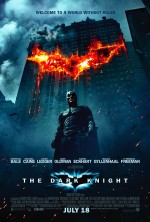2008 // USA // Andrew Stanton // July 27, 2008 // Theatrical Print
A - WALL•E delivers to the anemic landscape of science fiction cinema a much-needed shot of vitality and depth. This is especially the case for that rare subspecies of sci-fi film that WALL•E delightfully embodies, one that is at once engaging, challenging, and appropriate for children. If the film has a flaw--and its flaws are rare indeed--it is the filmmakers' dogged insistence on exploring a proflieration of ethical and philosophical quandries when a sublime little allegory might have sufficed. Lest I damn with faint praise, let's be clear about one thing: WALL•E is simultaneously the best animated film, children's film, and science fiction film of the year. The electricity that tingles within its comfortable tropes signals a turning point in Pixar's oeuvre, not to mention Disney's. Although it lacks the virtuosity that made the studio's Ratatouille one of the best films of 2007, WALL•E has an ache of grand ambition in its bones, one that bodes well for the potential of "children's entertainment" to still take people of all ages to undiscovered worlds without and within.
WALL•E himself ("voiced" by digital sound whiz Ben Burtt) is an oddly adorable little wonder, a vaguely anthropomorphic trash compactor with binocular eyes and bulldozer treads. His appeal owes much to the early magic of R2-D2, with some obvious visual and aural nods to E.T. and Short Circuit's Number Five. Director Andrew Stanton's approach to WALL•E's personality is a distinctly human one. This pint-size mechanical garbage man scans not so much as a representative of technology and its relationship to humanity, but more as a stand-in for humanity itself. Or, more particularly, for the Modern Individual: at once industrious and passive, full of queer habits and obsessions, and fundamentally alone and lonely. Laboring away in solitude in an urban apocalyptic wasteland, dutifully crushing mountains of trash into cubes and neatly stacking them, WALL•E calls to mind not an just an Omega Near-Man, but every person who toils in emotional isolation. WALL•E's Earth is one of toxic beauty and castoff majesty. Skyscrapers of rusting and crumbling junk tower into a firmament rendered overcast and sickly orange with pollution. There appears to be no life but cockroaches, and all the other robots of WALL•E's model lie in degrading heaps. This robot seems unaware that he is laboring in the graveyard of both his own kind and the whole of human civilization.
Into WALL•E's oddly peaceful world of daytime drudgery and nocturnal amusement—spent in the company of a meticulously organized junk collection and a precious videocassette of Hello, Dolly!—drops EVE, a sleek probe-robot left by a spaceship. EVE (Elissa Knight) is a late-model beauty, a glossy white capsule whose design clearly owes some debt to Apple. Whizzing over the blasted landscape of WALL•E's world and shooting anything that twitches with her plasma blaster, EVE is an automaton wholly unlike our humble protagonist. Not that this dissuades WALL•E, who becomes hopelessly infatuated with this new arrival. (Don't we all risk infatuation when we encounter something arresting in its strangeness and novelty?) EVE's appearance signals the end of WALL•E's flat, beige existence, and also heralds the film's eventual shift from elegant allegory to a more convoluted tale, one featuring bolder themes and more typical Pixar pop extravagance.
EVE, it turns out, is an emissary of Earth's exiled population, now dwelling—as motion-activated ads in WALL•E's barren cityscape still helpfully explain—in a titanic corporate spaceship. Said ship serves as a sort of interstellar resort-metropolis where a legion of robots attend to every need and coddle every whim. Centuries after an environmental apocalypse, obese space-dwelling humans now glide without effort through a world of garish advertisements, virtual activities, and lots and lots of food. It's both dazzling and horrifying, a triumph of futurist visualization that urges the viewer to gawk with envy and revulsion.
It is eventually revealed that EVE is crucial to humanity's future, although it is actually WALL•E who provides the key to its salvation. WALL•Es first act is a triumph: touching, gorgeously rendered, nearly wordless, it could be an animated short film. Almost inevitably, then, there is a nagging trace of a thematic seam at that first act's trailing edge. Thereafter, WALL•E unfolds into an admirable, compelling science fiction tale, but it also loses some of its joyous simplicity and humane resonance. It gets grander, denser, and more dizzying, with thick dollops of typical kinetic animated action. One gets the sense that this wasn't wholly necessary. WALL•E could have been a entirely respectable children's film (and a more enviable one at that) if it had maintained the slower pace and more innovative storycraft of its early scenes.
Still, the film juggles its expanding ambitions quite well. There is a gracefulness in the way it intertwines its twin tensions: WALL•E and EVE's romance (as it were) on one hand and humanity's fate on the other. There are gentle thematic echoes in this deft pairing that compensate for the dilution of the film's initial potency and giddy humor. If nothing else, the filmmakers are clear-eyed and sure-footed in their exploration of familiar science fiction elements, while eschewing the genre's typical sneering sanctimony and weepy despair. Although its Everyman allegory is always there, rippling with good-natured energy beneath the film's surface, WALL•E lustily tackles a plethora of weighty matters with a more direct line of attack.
And there is plenty to chew on: humankind's dependency on and infantilization by technology; the sanctity of primitive knowledge in the face of said same electronic isolation; the necessity for emotional connection whether one's life is meaningless drudgery or blissful comfort; and the role of corporations in manufacturing desire and encouraging consumption. Granted, kids will giggle along at all the robot mayhem—the brutal slapstick endured by WALL•E is outright hilarious—but there is plenty of Big Idea musing within the film's narrative, often forthrightly so. This may be the only factor that prevents WALL•E from achieving a kind of masterpiece sheen. It is both so assuredly about Big Ideas, and so ruthlessly cribs from the seminal works in the genre—2001 in particular, to the point of homage and then parody—that it lacks a sense of spontaneous novelty. This twinge of dissatisfaction, however, is about the roughest criticism I can lob at the film.
Despite the fact that its robot characters are ostensibly the protagonists, WALL•E has no time for speculation on how thinking machines might, well, think. The robots are humanized to the point where the notion that WALL•E and EVE might feel love is non-controversial. Pixar has created a film with robots but not particularly about robots, which is refreshing in a way. This isn't to say that the film doesn't do its robots well. Although they are decidedly non-human in appearance, the mechanical helpers that populate its world are astonishingly expressive. Certainly, they exhibit more diversity and passion than the tubby human exiles who putter around in their hover-chairs and slurp liquid cupcakes.
Of course, as much as we might see ourselves in a robot's wistful loneliness or his dogged pursuit of his beloved, WALL•EE also urges us to see ourselves in its human characters. Not only in their grotesque fetal passivity, but also in the ease with which a sedentary society can prodded into action and aspiration, often by the unlikeliest forces. Stanton asks us to believe that we can, as a civilization, come full circle to a primal awareness of our surroundings and thereby forestall ecological calamity. Perhaps most heretically, in a genre littered with Terminators and Agent Smiths, WALL•E suggests that our artificial helpmates can aid our journey to a healthier, richer, and more sustainable existence.









